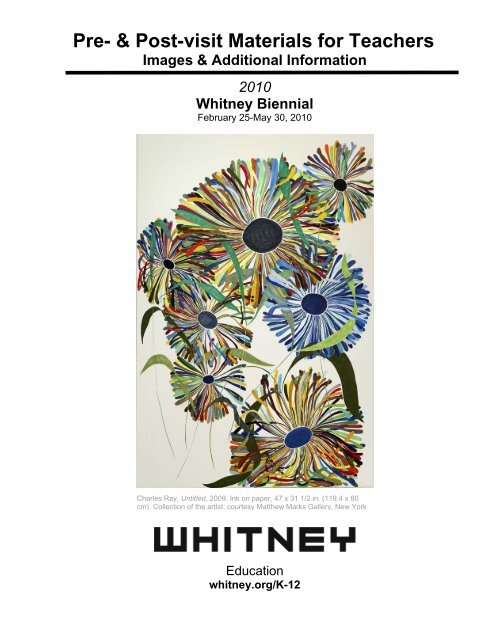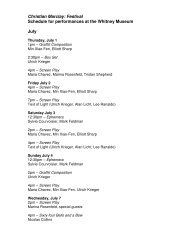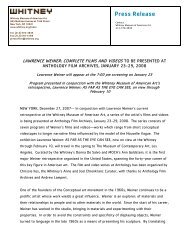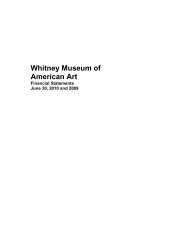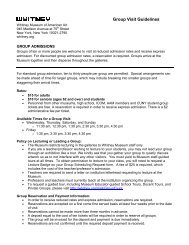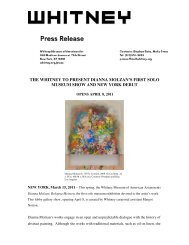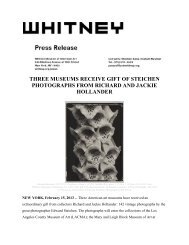Post-visit Materials for Teachers - Whitney Museum of American Art
Post-visit Materials for Teachers - Whitney Museum of American Art
Post-visit Materials for Teachers - Whitney Museum of American Art
You also want an ePaper? Increase the reach of your titles
YUMPU automatically turns print PDFs into web optimized ePapers that Google loves.
Pre- & <strong>Post</strong>-<strong>visit</strong> <strong>Materials</strong> <strong>for</strong> <strong>Teachers</strong><br />
Images & Additional In<strong>for</strong>mation<br />
2010<br />
<strong>Whitney</strong> Biennial<br />
February 25-May 30, 2010<br />
Charles Ray, Untitled, 2009. Ink on paper, 47 x 31 1/2 in. (119.4 x 80<br />
cm). Collection <strong>of</strong> the artist; courtesy Matthew Marks Gallery, New York<br />
Education<br />
whitney.org/K-12
Images <strong>for</strong> Pre and <strong>Post</strong> Discussions and Activities<br />
2010<br />
James Casebere, Landscape with Houses (Dutchess County, NY) #1, 2010. Digital chromogenic print, Edition <strong>of</strong> 5. <strong>Whitney</strong><br />
<strong>Museum</strong> <strong>of</strong> <strong>American</strong> <strong>Art</strong>, New York;purchase with funds from the Photography Committee and the Robert Mapplethorpe<br />
Foundation E.2009.1141<br />
© 2010 WHITNEY MUSEUM OF AMERICAN ART<br />
2
Images <strong>for</strong> Pre and <strong>Post</strong> Discussions and Activities<br />
2010<br />
James Casabere, Landscape with Houses (Dutchess County, NY) #2, 2010. Digital<br />
chromogenic print, Edition <strong>of</strong> 5. Collection <strong>of</strong> the artist; courtesy Sean Kelly<br />
Gallery, New York E.2009.1142<br />
© 2010 WHITNEY MUSEUM OF AMERICAN ART<br />
3
Images <strong>for</strong> Pre and <strong>Post</strong> Discussions and Activities<br />
2010<br />
For additional in<strong>for</strong>mation about 2010 artists, please <strong>visit</strong> http://www.whitney.org/Exhibitions/2010Biennial<br />
James Casebere’s photographs transport viewers into ambiguous, evocative, and surreal environments. Casebere’s process<br />
involves constructing tabletop models out <strong>of</strong> modest materials, such as Styr<strong>of</strong>oam, plaster, and cardboard. He then dramatically<br />
lights these constructions and carefully positions his camera to manipulate the composition and the mood <strong>of</strong> the resulting<br />
photograph. For Landscape With Houses (Dutchess County, NY) 1 and 2, Casebere constructed his grandest, most detailed model<br />
to date—a subdivision based on one in Dutchess County, New York.<br />
© 2010 WHITNEY MUSEUM OF AMERICAN ART<br />
4
Images <strong>for</strong> Pre and <strong>Post</strong> Discussions and Activities<br />
Collecting Biennials<br />
Duane Hanson, Woman with Dog, 1977. Cast polyvinyl polychromed in synthetic polymer, with cloth and hair, 46 ×<br />
48 × 51 1/2 in. (116.8 × 121.9 × 130.8 cm) overall. <strong>Whitney</strong> <strong>Museum</strong> <strong>of</strong> <strong>American</strong> <strong>Art</strong>, New York; purchase with<br />
funds from Frances and Sydney Lewis 78.6<br />
<strong>Art</strong> © Estate <strong>of</strong> Duane Hanson/Licensed by VAGA, New York, NY<br />
© 2010 WHITNEY MUSEUM OF AMERICAN ART<br />
5
Images <strong>for</strong> Pre and <strong>Post</strong> Discussions and Activities<br />
Collecting Biennials<br />
Edward Hopper, Early Sunday Morning, 1930. Oil on canvas, 35 3/16 × 60 1/4 in. (89.4 × 153 cm). <strong>Whitney</strong> <strong>Museum</strong> <strong>of</strong> <strong>American</strong> <strong>Art</strong>, New<br />
York; purchase with funds from Gertrude Vanderbilt <strong>Whitney</strong> 31.426<br />
©<br />
2010 WHITNEY MUSEUM OF AMERICAN ART 6
Images <strong>for</strong> Pre and <strong>Post</strong> Discussions and Activities<br />
Collecting Biennials<br />
Although Duane Hanson cast directly from an individual, his finished sculptures are never portraits <strong>of</strong> one particular person. He used his<br />
models as a starting point to create a type <strong>of</strong> person or character. Hanson’s models <strong>for</strong> Woman with Dog were a housewife from Fort<br />
Lauderdale, near where he lived, and his cousin’s pet poodle. Hanson’s casting technique allowed him to create life-size, realistic sculptures<br />
<strong>of</strong> his subjects. Following the setting and assembly <strong>of</strong> the limbs, the artist accurately painted skin, veins, and blemishes adding to the life-like<br />
quality <strong>of</strong> his figures. He also included many real elements, such as her dress and underwear (purchased at a discount store, along with her<br />
slippers), her watch, her glasses, the chair she sits in, the rug, and the letters she is reading. The dog is made <strong>of</strong> ceramic but includes the<br />
poodle’s actual hair clippings, collected from <strong>visit</strong>s to the groomer. In a private moment, the woman is oblivious to the viewer’s presence.<br />
Hanson’s realism catches and retains the viewer’s eye through the simple humanity <strong>of</strong> his subject.<br />
One <strong>of</strong> Edward Hopper’s most evocative works, Early Sunday Morning conveys the sense <strong>of</strong> isolation and solitude <strong>for</strong> which his art is<br />
renowned. Hopper described this painting as “almost a literal translation <strong>of</strong> Seventh Avenue” in New York City, yet he eliminated<br />
recognizable details and reduced the street to its bare essentials. Hopper also created a dramatic play <strong>of</strong> light and shadow on the empty<br />
street and buildings to convey an atmosphere that seems more theatrical than real. His “realism” is less involved with recording the<br />
photographic truths <strong>of</strong> a site than revealing a psychological reality, an emotion, or feeling.<br />
© 2010 WHITNEY MUSEUM OF AMERICAN ART<br />
7
Images <strong>for</strong> Pre and <strong>Post</strong> Discussions and Activities<br />
2010 <strong>Art</strong>ist In<strong>for</strong>mation<br />
The following artists may be <strong>of</strong> interest to your students (although some are not appropriate<br />
<strong>for</strong> younger audiences). For images and more in<strong>for</strong>mation, please <strong>visit</strong><br />
http://www.whitney.org/Exhibitions/2010Biennial<br />
Nina Berman's photographs document the rarely explored effects and harsh realities <strong>of</strong><br />
contemporary warfare. She engages the viewer with intimate images <strong>of</strong> the consequences <strong>of</strong> war<br />
that is <strong>of</strong>ten given short shrift in the popular media. The 2006 photographs on view in 2010<br />
document the marriage <strong>of</strong> <strong>for</strong>mer Marine sergeant Ty Ziegel, then twenty-four, to his high school<br />
sweetheart, Renee Kline, twenty-one. After being severely disfigured in a suicide bomber’s attack<br />
while stationed in Iraq, Ty underwent fifty reconstructive operations. Berman took spontaneous<br />
photographs <strong>of</strong> Ty and Renee in the weeks leading up to their wedding day and accompanied<br />
them when they had their wedding portrait taken. Berman returned to photograph Ty in 2008 and<br />
describes the later images as suggestive <strong>of</strong> “a com<strong>for</strong>table acceptance with military culture<br />
despite the cost.”<br />
Dawn Clements’s large-scale drawings depict interior domestic spaces, either her own<br />
surroundings or those in classic 1940s and 1950s Hollywood melodramas. She is especially<br />
interested in the idea <strong>of</strong> the home as a place <strong>of</strong> both com<strong>for</strong>t and confinement: “They are places,<br />
no matter how beautiful and wonderful they may appear, that are incarcerating <strong>of</strong> all these<br />
characters. The doors may be unlocked, but somehow the women can’t walk out the door.”<br />
Sculptor, urban planner, and per<strong>for</strong>mance artist Theaster Gates has trans<strong>for</strong>med the <strong>Whitney</strong>’s<br />
Sculpture Court into an installation that functions as a communal gathering space <strong>for</strong><br />
per<strong>for</strong>mances, social engagement, and contemplation. The spare architecture <strong>of</strong> the Main Pavilion<br />
references the artist’s respect <strong>for</strong> Eastern philosophy and art, while the main shoe shine temple<br />
and its activity <strong>of</strong> shoe shining infuses labor with dignity and humility. These architectural<br />
structures also elevate the status <strong>of</strong> simple and found materials. The wood that comprises the<br />
Main Pavilion and surrounding pathways was salvaged from the <strong>for</strong>mer Wrigley gum factory in<br />
inner-city Chicago and cleaned by Gates <strong>for</strong> its conversion into the walls <strong>of</strong> his sacred space.<br />
Throughout 2010, Gates will collaborate with historians, artists, and street musicians on a series<br />
<strong>of</strong> “monastic residencies.” These creative residents will trans<strong>for</strong>m and reinvent the Sculpture<br />
Court by adding what Gates describes as “commentary, bling, and acts <strong>of</strong> sincerity” to the<br />
installation.<br />
Kate Gilmore’s work explores themes <strong>of</strong> displacement, struggle, and female identity. She is the<br />
sole protagonist in her per<strong>for</strong>mative videos, in which she attempts to conquer self-constructed<br />
obstacles. For this work, Gilmore's obstacle is a tall column made <strong>of</strong> sheetrock. She tries to climb<br />
up the column by kicking and punching holes into its walls, and each puncture reveals splashes <strong>of</strong><br />
bright yellow paint from the interior <strong>of</strong> the two layers <strong>of</strong> sheetrock. She works through the<br />
limitations imposed by her feminine clothing—high-heels and a polka-dot dress—with sheer<br />
muscle power and desperate determination. Shot in one take, the outcome <strong>of</strong> her endeavor is<br />
unknown be<strong>for</strong>e the per<strong>for</strong>mance begins. Gilmore's tragicomic displays posit physical situations<br />
as metaphors <strong>for</strong> present-day conflicts and social obstacles.<br />
Thomas Houseago creates figurative sculptures that appear physically imposing and powerful in<br />
their size and positioning yet fragmented and vulnerable in their construction. To construct these<br />
works, Houseago begins with a structure <strong>of</strong> iron rods and then adds a variety <strong>of</strong> traditional<br />
sculptural materials such as plaster, hemp, and wood. Some <strong>of</strong> his works incorporate graphite or<br />
charcoal sketches <strong>of</strong> faces and anatomy on plaster and wood panels. Monstrous yet<br />
© 2010 WHITNEY MUSEUM OF AMERICAN ART<br />
8
unthreatening, this work, called Baby,--a part-human, part-animal being, is in a transitional pose<br />
between walking and crawling, weighted on the flat expanses <strong>of</strong> its plaster hands and feet.<br />
Martin Kersels’s oversized assemblage <strong>of</strong> found and fabricated objects is at once a sculpture<br />
and a per<strong>for</strong>mance space that he and other artists, musicians, choreographers, and directors will<br />
use throughout the Biennial. While Kersels's sculptures have long incorporated action or<br />
per<strong>for</strong>mance, this project suggests a specific parallel between making art and making a pop music<br />
album. Each section <strong>of</strong> the stage is titled as a different "song," and in the way that an album is<br />
composed <strong>of</strong> "singles," each functions as an individual work and as a part <strong>of</strong> a larger whole.<br />
Serving as a space <strong>for</strong> per<strong>for</strong>mance, the objects also take on a time-based quality, one inherent in<br />
music, but not <strong>of</strong>ten associated with sculpture, and raise questions about the nature and<br />
possibilities <strong>of</strong> the medium.<br />
Daniel McDonald blends images from popular culture with political satire in dollhouse-scale<br />
narrative tableaux that address contemporary social issues. His precisely detailed, threedimensional<br />
dioramas are peopled with toy figurines from different, incongruous cultural sources.<br />
In this work, McDonald presents an allegory <strong>of</strong> the current U.S. economic crisis. <strong>American</strong> popmusic<br />
icon Michael Jackson, wearing garb from his epic 1982 music video Thriller, steps onto the<br />
boat <strong>of</strong> Charon, the ferryman who, in Greek mythology, transports the recently deceased to the<br />
underworld. While Jackson dutifully <strong>of</strong>fers a coin as payment <strong>for</strong> his voyage, Uncle Sam,<br />
unconscious and inebriated at the other end <strong>of</strong> the boat, has no money to appease Charon. The<br />
drama <strong>of</strong> the scene is heightened with theatrical effects such as stage lighting, a smoke machine,<br />
and variations in scale.<br />
Curtis Mann’s photographs contain fragments <strong>of</strong> scenes that are partially erased and obscured.<br />
Mann’s process draws attention to the artifice <strong>of</strong> the photographic medium by demonstrating the<br />
malleability <strong>of</strong> images. He begins by culling images <strong>of</strong> strife and conflict in various international<br />
locations from photosharing websites such as Flickr and then has prints made. Once he has the<br />
prints in hand he covers portions <strong>of</strong> the photographs with a protective varnish and pours bleach<br />
over each one, stripping away areas not coated with varnish.<br />
In After the Dust, Second View (Beirut), Mann has arranged a grid <strong>of</strong> snapshots <strong>of</strong> the 2006 war<br />
between Israel and Hezbollah. Taken together, the images resemble remnants <strong>of</strong> an explosion.<br />
What remains are mostly fragments <strong>of</strong> buildings in settings that lack substantive visual clues,<br />
preventing a coherent understanding <strong>of</strong> the larger context. Through the physical destruction and<br />
manipulation <strong>of</strong> these images, Mann questions the medium’s reliability as a documentary tool,<br />
troubling the ability <strong>of</strong> the photograph to convey truth.<br />
Although Ari Marcopoulos shot Detroit while <strong>visit</strong>ing friends in that city, this work captures the<br />
energy and open-ended feel <strong>of</strong> the videos and photographs he makes at home with his own<br />
teenage sons in Sonoma, Cali<strong>for</strong>nia. Since emigrating from his native Holland in 1979,<br />
Marcopoulos has documented the diverse subcultures <strong>of</strong> <strong>American</strong> youth—from the brash vitality<br />
<strong>of</strong> underground music to the rebellious athleticism <strong>of</strong> skaters and snowboarders—with<br />
anthropological sensitivity. Detroit merges his attention to particularities <strong>of</strong> cultural identity with the<br />
intimacy <strong>of</strong> a home movie. The kids in the video skillfully adapt the gritty conventions <strong>of</strong> noise rock<br />
<strong>for</strong> an audience <strong>of</strong> family and friends.<br />
Through carefully composed installations, photographs, and films, Josephine Meckseper<br />
exposes the political ramifications <strong>of</strong> America’s culture <strong>of</strong> consumption. In this work, Meckseper<br />
uses a video camera to explore Minneapolis’s Mall <strong>of</strong> America—one <strong>of</strong> the top tourist destinations<br />
in the United States—pausing to examine window displays, sale signs, and dormant rides in its<br />
indoor amusement park. Meckseper then manipulates the footage, employing ironically patriotic<br />
red and blue filters—a technique inspired by French filmmaker Jean-Luc Godard. The artist also<br />
turns the footage on its side and adds a vaguely sinister soundtrack. The result is an abstraction<br />
© 2010 WHITNEY MUSEUM OF AMERICAN ART<br />
9
<strong>of</strong> otherwise documentary images and a sense <strong>of</strong> alienation and disorientation. The mall becomes<br />
a hostile, dangerous place.<br />
Rashaad Newsome has created a video <strong>of</strong> a man dancing by himself in a white room. He asks<br />
dancers to per<strong>for</strong>m “vogue” dance moves. Vogue is a <strong>for</strong>m <strong>of</strong> modern dance that is inspired by<br />
poses in fashion magazines. The artist says, “I view these videos as drawings with the dancers<br />
acting as my pens creating lines, shapes, landscapes, and …narratives.”<br />
Charles Ray’s drawings <strong>of</strong> flowers are at once cheerfully lifelike and eerily abstract. Rendered in<br />
bright hues or deep blacks, the flowers occupy the page in fluid arrangements. Yet the individual<br />
petals are also composed <strong>of</strong> discrete plumes <strong>of</strong> color, as though Ray conceived <strong>of</strong> each as a<br />
separate <strong>for</strong>mal element be<strong>for</strong>e joining several in a tenuous whole. Ray is best known <strong>for</strong><br />
sculptural works that painstakingly replicate everyday objects, but with subtle, psychologically<br />
charged alterations that confound the distinction between real and unreal. His depictions <strong>of</strong><br />
flowers extend a longstanding interest in the beauty <strong>of</strong> natural <strong>for</strong>ms that characterize his threedimensional<br />
work.<br />
Aki Sasamoto’s installations and per<strong>for</strong>mances explore the nuances and peculiarities <strong>of</strong><br />
everyday life. She uses sculpture, movement, video, and sound to trans<strong>for</strong>m mundane actions<br />
into theatrical events. Strange Attractors consists <strong>of</strong> a careful arrangement <strong>of</strong> sculpturally altered,<br />
found objects that take on new roles and provide guidance <strong>for</strong> Sasamoto’s improvisational<br />
per<strong>for</strong>mances that take place within the installation.<br />
Ania Soliman’s work, NATURAL OBJECT RANT: The Pineapple comprises twenty-six<br />
montages, each corresponding to a letter <strong>of</strong> the alphabet, and twenty-six text panels that explore<br />
the pineapple's history as an exotic commodity tied up with the politics <strong>of</strong> colonialism.<br />
Reminiscent <strong>of</strong> Dadaist photomontages from the 1930s such as those by German artist Hannah<br />
Höch, each montage is a hybrid <strong>of</strong> two digital images, sourced from the internet. The<br />
accompanying panels <strong>of</strong> text are written by the artist and in<strong>for</strong>med by her research and<br />
impressions on the subject <strong>of</strong> the pineapple and its historical significance.<br />
Storm Tharp builds his strange and beautiful characters from a series <strong>of</strong> ink drops in water,<br />
improvising and developing the image from feathered lines and washes <strong>of</strong> ink as he works. Tharp<br />
takes his inspiration from a wide-ranging set <strong>of</strong> influences including 1970s <strong>American</strong> cinema and<br />
Japanese portrait prints. His characters have names, histories, and narratives, but suggest<br />
multiple interpretations.<br />
According to Tam Tran, she trains her camera on “everything and anything my eyes see and<br />
love.” Tran’s series <strong>of</strong> photographs presents her subjects as multi-faceted characters, who<br />
explore and experiment with their respective identities by taking on a multitude <strong>of</strong> personas. In the<br />
series Raising Hell (2008), the artist’s nephew enacts a typical childhood fantasy <strong>of</strong> being a<br />
superhero. He is featured wearing a costume <strong>of</strong> pajamas and a cape and uses a broomstick as a<br />
weapon. Each <strong>of</strong> the five photographs captures a different moment in the battle between the boy<br />
and his imagined backyard adversary.<br />
Pae White's work encourages viewers to take a deeper look at familiar encounters and ordinary<br />
objects to the end <strong>of</strong> enriching everyday experience. Ignoring traditional boundaries between the<br />
applied and fine arts, White draws attention to what she calls "the spaces between things" in<br />
transient sculptural installations and graphic design projects that are temporary by nature. In 2006<br />
White began creating tapestries with photographic images <strong>of</strong> crumpled aluminum foil and, later,<br />
plumes <strong>of</strong> smoke. Still, Untitled (2010) is the latest <strong>of</strong> the smoke tapestries, which stage what<br />
White describes as the cotton’s “dream <strong>of</strong> becoming something other than itself” by contrasting an<br />
image <strong>of</strong> something immaterial with the physicality <strong>of</strong> fabric.<br />
© 2010 WHITNEY MUSEUM OF AMERICAN ART<br />
10
Images <strong>for</strong> Pre and <strong>Post</strong> Discussions and Activities<br />
Collecting Biennials <strong>Art</strong>ist In<strong>for</strong>mation<br />
The following artists may be <strong>of</strong> interest to your students (although some are not appropriate<br />
<strong>for</strong> younger audiences). For images, please <strong>visit</strong> http://www.whitney.org/Collection<br />
Lee Bontecou’s work, Untitled ,1961 hangs on the wall and emerges two feet into space, merging<br />
mediums <strong>of</strong> painting and sculpture. It includes materials such as saw blades, wire, and canvas.<br />
Beginning in 1959, Bontecou began making large-scale abstract works by scavenging <strong>for</strong> burlap<br />
and canvas, the latter cut from worn out conveyor belts discarded from the laundry below her<br />
house. A consistent motif quickly emerged: a central cavity built up from the rectangular frame <strong>of</strong><br />
the metal skeleton, projecting a foot or more <strong>of</strong>f the wall, and opening into the blackness <strong>of</strong> a layer<br />
<strong>of</strong> velvet or soot. The <strong>for</strong>ms and evocations <strong>of</strong> Bontecou’s wall reliefs are frequently described by<br />
an abiding tension between the organic and mechanical, the handmade and mass-produced, the<br />
biomorphic and the military-industrial.<br />
David Hammons finds inspiration in the streets and everyday life <strong>of</strong> his Harlem community,<br />
where he gathers ordinary, discarded, or ephemeral materials and trans<strong>for</strong>ms them in sculptures.<br />
In this untitled sculpture, he has planted copper wires in stones and wrapped the wires in hair<br />
picked up from the floors <strong>of</strong> barber shops. The overall effect is <strong>of</strong> a giant, spidery insect—or a<br />
spiky head <strong>of</strong> dreadlocks. He’s been working with hair since the mid-1970s.It’s significant to him<br />
that it’s acquired free-<strong>of</strong>-charge (like bottle caps and many <strong>of</strong> his other preferred materials), and<br />
seems in a sense like a gift. Also, it has a past—many people are literally woven into a work like<br />
this one, and so it has an almost magical, animate presence.<br />
Mike Kelley’s work, More Love Hours, includes a multitude <strong>of</strong> animals, dolls, and blankets that<br />
have been sewn together. Kelley has created art in different media including sculpture, drawing,<br />
video, per<strong>for</strong>mance, and painting. During the late 1980s and early 1990s, he began working with<br />
stuffed animals and afghans found at thrift stores and yard sales, to create art that explores and<br />
questions what it means to grow up in America. By using cast-<strong>of</strong>f animals and objects, Kelley was<br />
able to strike a common chord—the thrown-away objects that were once greatly used and loved<br />
now signify growing up, and a society in which one can be too old to cherish a blanket or stuffed<br />
monkey.<br />
Glenn Ligon is interested in words and text and how they might represent or misrepresent a<br />
given idea. In Untitled (I Do Not Always Feel Colored), Ligon borrowed a phrase from Zora Neale<br />
Hurston's 1928 essay "How It Feels to Be Colored Me." In this essay, Hurston described how she<br />
did not see herself as black or different from other people until, at the age <strong>of</strong> thirteen, she was<br />
sent to school outside <strong>of</strong> Eatonville, Florida, the tightly-knit African-<strong>American</strong> community where<br />
she grew up. The words in this work were created by rubbing black oil stick through plastic letter<br />
stencils onto the white painted surface <strong>of</strong> a door painted with gesso. The door was a support that<br />
Ligon liked because its proportions suggested the human body. As he worked his way down the<br />
door, and with repeated use <strong>of</strong> the stencils, the greasy oil stick stuck to the stencils and the text<br />
became smudged and illegible. The process <strong>of</strong> repetition and smudging created a surface <strong>of</strong> paint<br />
and language that can be both read and seen at the same time, suggesting multiple meanings<br />
and associations.<br />
© 2010 WHITNEY MUSEUM OF AMERICAN ART<br />
11
Claes Oldenburg has made giant, s<strong>of</strong>t, sewn and stuffed sculptures <strong>of</strong> everyday objects such as<br />
hamburgers, lipstick, toilets, sinks, and bathtubs. He has recreated these objects in unexpected<br />
ways, separating them from their original function, scale, or physical context. Oldenburg was part<br />
<strong>of</strong> the Pop <strong>Art</strong> movement. S<strong>of</strong>t Toilet is one in a series <strong>of</strong> sculptures relating to the theme <strong>of</strong> "the<br />
home," in which common domestic objects—a washstand, a medicine cabinet, a bathtub—<br />
behave more like s<strong>of</strong>t, pliable bodies than rigid, industrially produced objects. Oldenburg created<br />
sculptures <strong>of</strong> these objects by changing their material and scale. S<strong>of</strong>t Toilet has similar<br />
proportions to a toilet, but it is about twice the size <strong>of</strong> a real one.<br />
Paul Pfeiffer uses digital technology to alter images from sports broadcasts and Hollywood<br />
cinema in sculptures, installations, and photographs. Through these alterations, such as stops,<br />
stutters, and reverse action, he draws out subtexts and creates scenes <strong>of</strong> heightened<br />
physiological tension.<br />
From 1954 to 1964, Robert Rauschenberg created a new <strong>for</strong>m <strong>of</strong> art that he called combines.<br />
These works <strong>of</strong> art brought together elements <strong>of</strong> painting, sculpture, and collage in free-standing<br />
structures or wall reliefs. Satellite is one <strong>of</strong> Rauschenberg’s earlier combine paintings. Attached to<br />
the canvas are comic strips, postcards, pinups, scraps <strong>of</strong> wallpaper, two doilies, a washcloth, and<br />
a pair <strong>of</strong> socks. On to many <strong>of</strong> these found objects, Rauschenberg applied areas <strong>of</strong> brightly<br />
colored paint that dripped down the canvas, and narrow horizontal lines <strong>of</strong> thick oil paint. Perhaps<br />
the most startling component <strong>of</strong> this work <strong>of</strong> art is the stuffed, painted pheasant that appears to be<br />
strolling along a shelf that runs along the length <strong>of</strong> the painting’s top edge.<br />
For Rauschenberg, everyday objects were suitable, because they grounded his art in reality. “I<br />
don’t want a picture to look like something it isn’t. I want it to look like something it is. And I think a<br />
picture is more like the real world when it’s made out <strong>of</strong> the real world.”<br />
Mark Rothko applied thin layers <strong>of</strong> paint so that the layers <strong>of</strong> color showed through and the<br />
paintings appeared to glow. He wanted his paintings to express emotions and change the space<br />
where they were, so they would affect the viewer's mood, feelings, and thoughts. Rothko said that<br />
he painted large pictures so that the viewer could be surrounded by color and feel like he or she<br />
were in the painting. He felt that the works could express emotions but without recognizable<br />
imagery. The impact <strong>of</strong> these works is <strong>of</strong>ten described in spiritual as well as emotional terms.<br />
Rothko however, avoided explaining the content <strong>of</strong> his work. He believed that the abstract image<br />
could directly represent the human condition: "My current pictures are involved with the scale <strong>of</strong><br />
human feeling, the human drama, as much <strong>of</strong> it as I can express."<br />
George Tooker was part <strong>of</strong> a small group <strong>of</strong> artists whose precise, physiologically charged<br />
artwork set them apart from the era’s more mainstream practitioners <strong>of</strong> Abstract Expressionism.<br />
His work <strong>of</strong>ten deals with the isolation and injustices <strong>of</strong> contemporary urban society, giving a<br />
visual <strong>for</strong>m to cold war America’s confusion and despair.<br />
Andy Warhol is one <strong>of</strong> the central figures <strong>of</strong> the Pop <strong>Art</strong> movement and has become one <strong>of</strong> the<br />
most influential artists <strong>of</strong> the second half <strong>of</strong> the twentieth century. His works, <strong>of</strong>ten comprised <strong>of</strong><br />
images <strong>of</strong> consumer products, reflect the experience <strong>of</strong> popular culture, mass production, and the<br />
<strong>American</strong> Dream.<br />
© 2010 WHITNEY MUSEUM OF AMERICAN ART<br />
12


